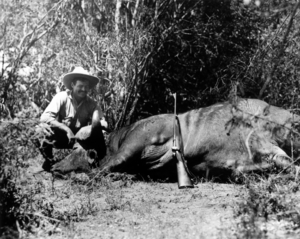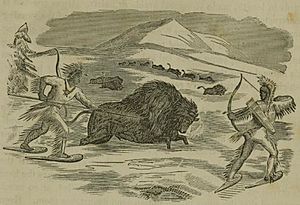Big-game hunting facts for kids
Big-game hunting is when people hunt very large wild animals. They might do this for different reasons: to get meat, to collect valuable parts like horns or tusks, for trophies (like mounted heads), or just for fun and recreation.
When people talk about big-game hunting, they often think of Africa's "Big Five" animals. These are the lion, African elephant, Cape buffalo, African leopard, and rhinoceros. In places like the Indian subcontinent, hunters might go after tigers and different kinds of rhinos. Other large animals hunted include kudu, antelope, and hartebeest.
In North America, some of the biggest animals hunted are whales, moose, elk, caribou, bison, and different types of deer. Most big-game hunting today happens in North America.
Big-game hunting takes place on every continent except Antarctica. This is because other continents have ecosystems that can support very large animals. For example, in Africa, people hunt lions, Cape buffalo, elephants, and giraffes, often for trophies. In North America, animals like bears, wolves, walruses, and alligators are hunted. In Europe, you might find hunting for bears, bison, and deer. Australia has kangaroos and wild boars that are hunted.
Contents
History of Big-Game Hunting
Hunting large animals for food is a very old practice. It probably started when early humans, Homo sapiens, first appeared. Even earlier human-like creatures might have hunted too. Cave paintings show that early humans hunted mammoths in groups. They used spears or large rocks, or sometimes they would chase animals off cliffs.
Around 8,000 BCE, cultures like the Clovis and Folsom were mainly big-game hunters. Their hunting activities ended around the same time that many large Ice Age animals, called Pleistocene megafauna, became extinct.
Hunting in the Victorian Era
Big-game hunting also became a popular sport. People hunted to collect animal specimens for museums, for fun, or as a hobby. This sport became very popular during the Victorian era and reached its peak in the 20th century.
Many famous big-game hunters existed during this time. Some well-known hunters include Theodore Roosevelt and Ernest Hemingway, who were also guided by skilled hunters like Philip Percival. Interestingly, many big-game hunters, like Roosevelt and Hemingway, were also interested in conservation. Today, the money from big-game hunting in Africa often helps pay for efforts to protect wildlife. Hunters pay large fees that go directly to managing and protecting animal populations.
Hunting Methods
Hunters have developed many ways to hunt big game over hundreds of years. The main methods used today are:
- Stalking: This means quietly following an animal until you can get close enough to make a kill. Hunters try to hide their appearance, smell, or sound so the animal doesn't notice them. Stalking can sometimes take days. Tracking animals is a very old skill that hunters still use successfully today.
- Ambush: This method involves waiting for the animal to come to you. Hunters use blinds (hidden spots) to stay out of sight. These can be simple ground blinds, tree stands, or special structures. Sometimes, hunters use bait to attract the animals to their ambush spot.
- Driving: This is when hunters direct the animal's movement. They might send people or dogs through an area to make noise and push the animal in a certain direction. The animal might be driven towards a trap, a cliff, or a place where the hunter can shoot it.
- Vehicles: Sometimes, vehicles like cars or even planes are used. They can help hunters find animals or get closer to them faster. Vehicles can also be used as a type of blind.
Weapons Used for Hunting

Hunters use different kinds of weapons for big-game hunting. These include firearms, bow and arrows, spears, and atlatls (spear-throwers). Some hunters also use close-range weapons like knives or axes.
The most common weapon used by hunters is the rifle. Other firearms like shotguns and handguns are also used. For big game, hunters usually choose large-caliber ammunition. This helps to take down the animal quickly and humanely. Ethical hunters always aim for a clean, humane kill.
Advances in ammunition and guns allow for longer-range kills. Some common types of ammunition for big-game hunting include .30-30 Winchester, .30-06 Springfield, and .300 Winchester Magnum. The science of ballistics (how bullets fly) is always improving.
Hunting with a bow and arrow is also popular, especially for skilled hunters. There are many types of bows, like longbows, recurve bows, and compound bows. Arrows are made from different materials, and Arrowheads come in various shapes.
Some hunters enjoy the challenge of using more traditional or "primitive" weapons like spears and atlatls. This requires a lot of skill and knowledge.
Hunting Ethics
As more people hunt and wild animal populations face challenges, it's very important for big-game hunters to act ethically. Groups like the Boone and Crockett Club promote "fair chase" hunting. This idea means there should be a balance between the hunter and the hunted. It allows hunters to succeed sometimes, but animals should generally be able to escape.
The philosopher José Ortega y Gasset wrote about hunting and suggested a thoughtful approach. Another author, James Posewitz, explained that ethical hunting means allowing animals to avoid being taken most of the time.
Some people believe that hunting is right if it connects us back to nature. They argue that even when hunting for trophies, hunters should still eat the meat from the animals they kill. This is because humans have evolved as predators.
Economic Impact of Hunting
Big-game hunting can have a big impact on the economy and on conservation efforts. For example, in the Bubye Valley Conservancy in Zimbabwe, hunting fees have helped manage lion and rhinoceros populations successfully.
In North America, big-game hunting brings in a lot of money. The state of California estimated that hunting added over $263 million to its economy in 2016. Wyoming estimated a $224 million impact in 2015. Many studies show that when big-game hunting is well-managed, it can have positive economic effects.
At the start of the 20th century, there were about 500,000 rhinos in Africa and Asia. By 1970, this number dropped to 70,000, and today, only about 29,000 rhinos remain in the wild. Most rhinos now live in national parks and reserves because of poaching and habitat loss. However, the number of white rhinoceroses in Africa has actually increased from 100 in 1916 to over 18,000 in 2016. This is largely because of private game reserves that allow hunting. Some hunts can cost hundreds of thousands of dollars, and these fees are then used directly for conservation, helping to protect the animals.
It's important to remember that these positive results depend on ethical hunting practices. Unethical hunting can have negative effects on wildlife around the world.
Images for kids
-
The Duke of Algeciras with a trophy African leopard, one of the 'big five', in Southern Rhodesia, 1926.
See also
 In Spanish: Caza mayor para niños
In Spanish: Caza mayor para niños




